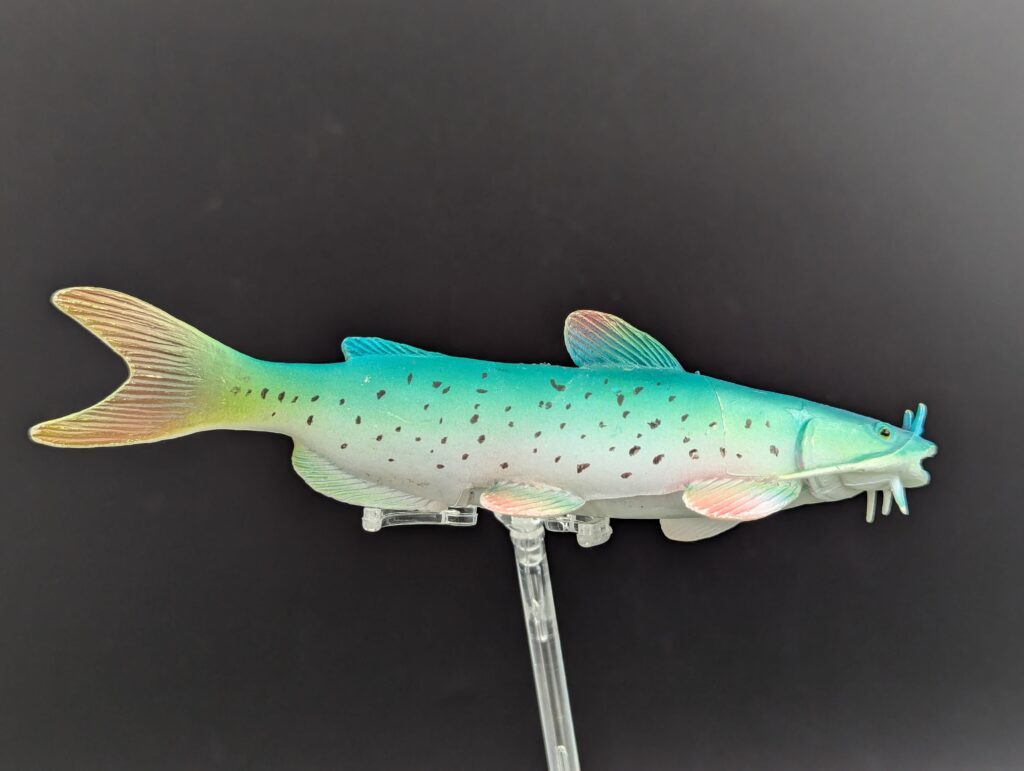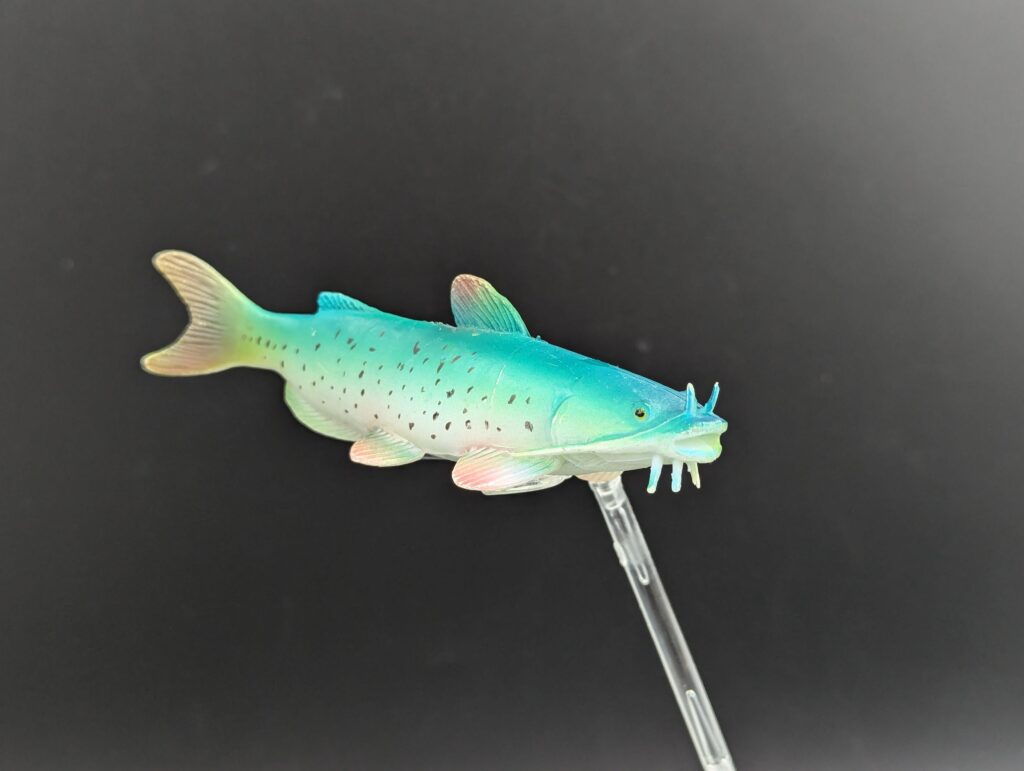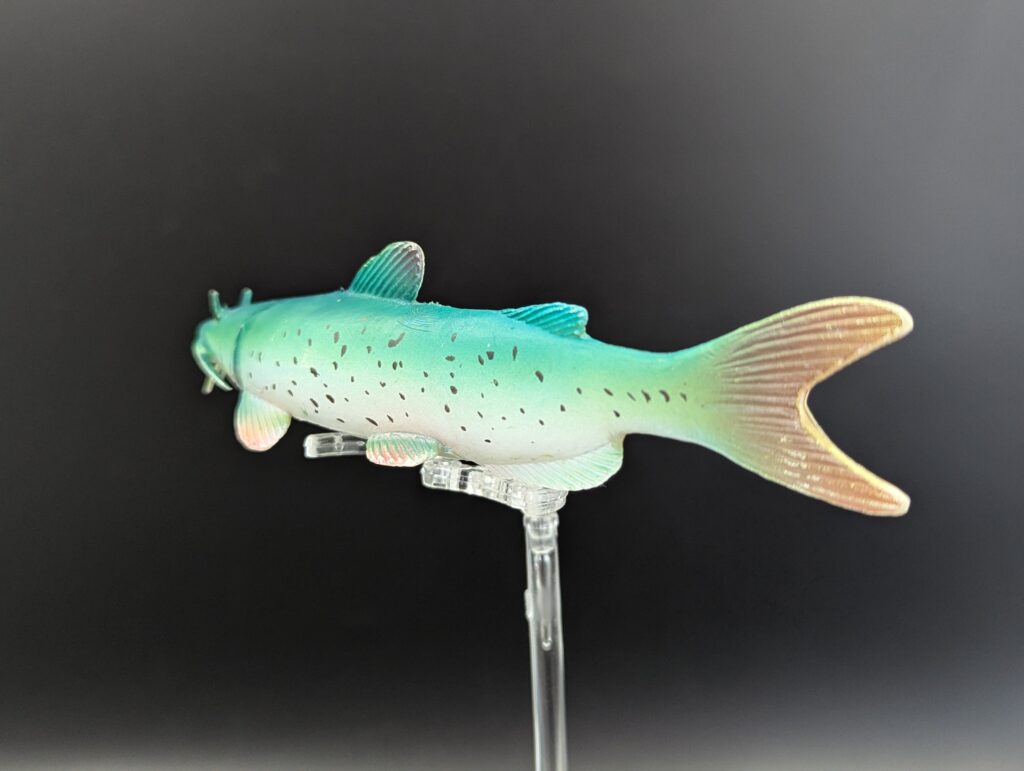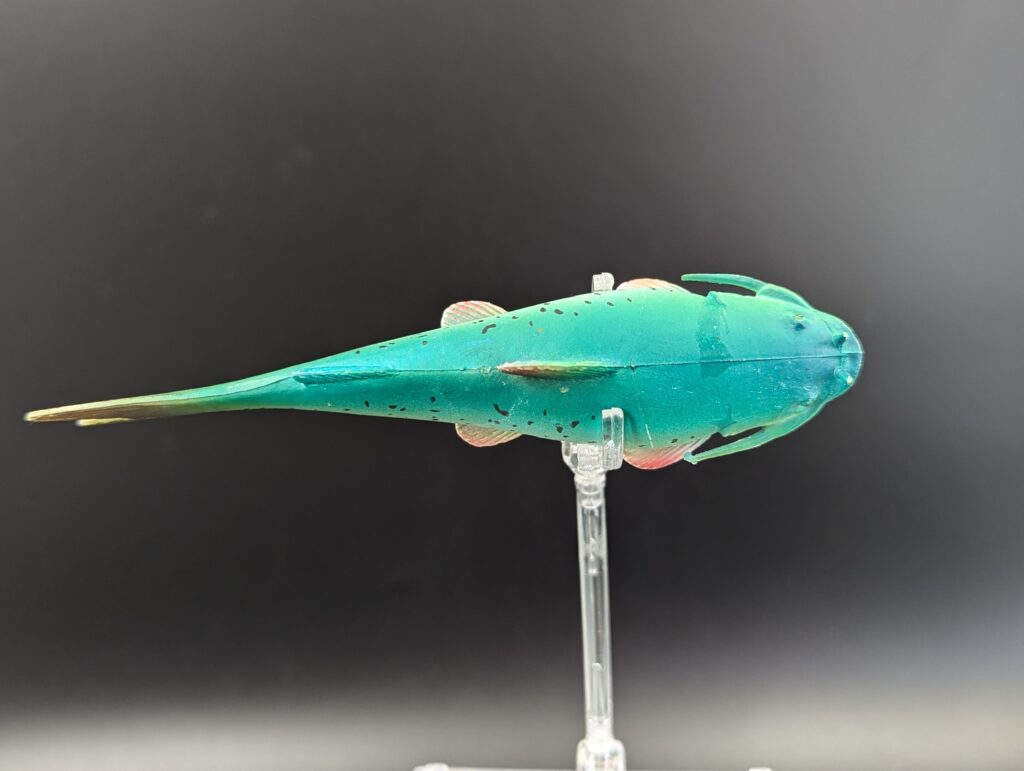
I guess it’s been too long since a fish review…or maybe I just realized it would be good to start reviewing the long-lost series of figures from Replica Toy Fish (RTF). For those not aware, this was a company that existed from around 2010 to 2017 or so. In that time, several wonderful fish models were made, focused almost exclusively on freshwater North American species, primarily ones familiar to anglers (that was the originally conceived target market…don’t get me started). There were two types of figures, toob sized 3 inch figures, and larger six inch figures. When production issues started to get insurmountable, the founder ended the line and brought out the Toy Fish Factory (TFF). Some of the species in TFF were reissued from RTF (different sculpts/paint though) in the same three inch style, but one thing that didn’t see any revising is the larger six inch RTF figures. So I’m going to start with one of those.

The figure today is one that was probably the most popular–and the one that ran out of stock first! It is the large channel catfish, Ictalurus punctatus. As was common with the RTF series, the focus was on species popular with anglers and as a species referred to as the ‘most fished in the United States’ would probably make great sense! It’s also the most populous species of of catfish, and is the official state fish for four states (Kansas, Missouri, Nebraska, and Tennessee) although they range well beyond those states, found from southern Canada (Manitoba, Ontario and Quebec), eastern and northern states, and northern Mexico. They are also introduced/invasive in parts of South America, Europe and Asia, usually for aquaculture purposes, at least to begin with. As can be imagined, the IUCN lists the species as Least Concern.

Channel catfish are not especially picky about their habitats, thriving in rivers, ponds, streams and reservoirs. When breeding, channel catfish will find crevices or hollows to lay eggs out of the stream current. For feeding, channel catfish hunt with a highly developed sensory system of chemoreceptors throughout the skin and mouth, in particular on the four barbels surrounding the mouth. This is important since channel cats, like most of the genus, are more adapted to murky waters so have limited eyesight. The ability to ‘smell’ the water allows the catfish to find prey (and avoid predators). Prey for channel catfish varies depends on their size, but they will take a wide range of animals, primarily fish, but will take any vertebrate or invertebrate that might fit; but they will also eat vegetation like algae or seeds. Juvenile channel catfish are more likely to be omnivorous, while adults are more predatory.

Adult channel catfish average around 67cm (26 inches), and between 1 and 2 kg (2-4lbs) but a record holder from 1968 was 58 pounds…which seems like a pretty incredible range of size (around 160cm…like 62 inches! I used math to figure that out.) It appears that channel cats tend to increase in mass based on length at a greater rate than most fish–there’s a whole formula that can be used for predictions, and lots of charts online.

So given the popularity and familiarity of channel catfish it makes sense that it would be one of the six species chosen as a big model for Replica Toy Fish. First thing to notice is the size and shape–it’s a fairly big model, about 14 centimetres/5.5 inches long. Okay, first off, none of the 6-inch series figures are actually six inches long (the 3-inch series hewed closer, more or less). Anyway, assuming a 67cm fish, it would make the scale about 1:5 or so. Assuming a larger fish would give a different scale of course. The model itself is a solid figure, not hollow, sculpted in a straight body; this is another feature of Replica Toy Fish (and Toy Fish Factory)–the figures were meant to act as 3D field guide models, so there was no motion or curves in the sculpts. The body is turquoise along the dorsum, fading at the midline to white along the belly. Across the sides of the body are a number of small black spots and blotches. This colouring is interesting, but not all that reminiscent of a real channel catfish, which are usually more brown (in some ways it reflects a blue catfish).

The figure has been sculpted well enough to demonstrate the features we’d expect in a channel catfish. The body is depicted as smooth, with no scales (as appropriate for a catfish), with a few seams visible along the sides of the belly, midline of the head, and around the widest part of the body. It is sometimes possible to see the myomere-lines of a channel catfish along the sides, but this is not visible here. The head is well done showing a terminal mouth, slightly open, with one pair of short upper-mouth barbels, two pairs of of short barbels on the chin, and a single long barbel along the the mid-line of the mouth. They short ones are a bit short, but otherwise they all reflect a channel catfish’s normal whiskers, but at least most are quite thin. On the upper and lower lip there is also a single tiny barbel in the midline…I think it’s actually a molding issue, I don’t think those are found on channel catfish. Behind the upper barbels are the eyes, clearly sculpted as raised and well-painted with black pupils. The opercula is also sculpted well, and below the throat are folds indicating a mouth that can expand quite a bit for inhaling prey.

Along the body we have the proper complement of finnage, all of which clearly show distinct fin rays. Most of the fins are quite rounded along the outer edges, which isn’t quite correct for real channel catfish, which tend to have a more squared appearance to the dorsal and paired fins, and also extend much further out from the body. The smaller adipose fin appears about right, while the anal fin is a little off–it is about long enough, but appears to be much shorter at the front end, expanding to a deeper, rounded distal end; in the real channel catfish the anterior edge should be the deeper edge, becoming shorter toward the rear. The caudal fin is deeply forked and roughly symmetrical, coloured with red highlights, as are the tips of the paired fins and dorsal fin. The tips are a bit more rounded than expected on a channel catfish, but reasonably close. The underside of the body and fins are left white

So overall, a fairly decent representation of a channel catfish, or at least an Ictalurus species of some kind. Oddly, despite their popularity with anglers the genus isn’t often represented as figures or toys. Maybe the whiskers are daunting or something? Anyway, while the figure isn’t a perfect match for a channel catfish (fins and colouring especially) it is a pretty good one overall, and honestly won’t matter for most people. One of the reasons I chose to start with the RTF 6″ channel catfish is because it was the first of the entire line of figures to go out of production, despite being the most popular one. Overall, I found the larger figures to be more popular, maybe the size was more playable? They are smaller than current Incredible Creatures fish models, and more in line with the Bullyland freshwater fish or some of the Colorata ones (deeper cuts, perhaps). I’d say people should look for these…but they’re not easily found, and unlikely to be available (unless some weirdo had a habit of having two full sets with one in storage, but who would do that…‽) Anyway, I look forward to exploring the whole line, including some unreleased models (as far as I have) over the next while. Next time will likely be one of the original 3″ sets!

Disclaimer: links to Ebay and Amazon on the AnimalToyBlog are affiliate links, so we make a small commission if you use them. Thanks for supporting us!



